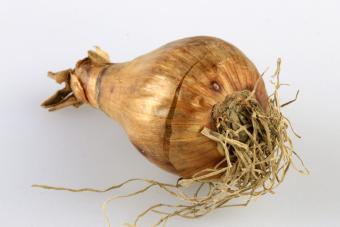
If you're looking for a fast-growing, late bloomer that provides color to your yard in the fall, consider adding the red spider lily to your backyard landscape. This colorful flower is easy to grow in most conditions, so if you have an area that is difficult to plant due to poor soil, this may be just what you are looking for.
Basic Growth and Flowering
Red spider lilies are also called hurricane lilies because they begin blooming during the height of hurricane season in September and October, and especially after a heavy rain. They have no foliage when they sprout and start blooming.
- Stems - Each bulb produces up to four green stems that suddenly sprout from the ground in early to late September or early October and quickly grows to a height of about 18 inches in about a week's time.
- Blooms - When the plant blooms, about six to eight individual bright red flowers open up to create a large, umbrella-shaped bloom that is over seven inches in diameter.

The flowers only last several weeks and once they wither and die, only then do the straplike leaves appear. The plant holds the leaves throughout the rest of the year until summer when they too die. For several weeks the plant has no foliage until it's time for the flowers to reemerge from the soil and start the blooming process all over again.

Planting Tips
Similar to tulips, the red spider lily (Lycoris radiata) does not produce seeds to start new plants. Instead, you'll be planting bulbs, with the optimal time to plant usually being spring, although you can plant the bulbs during the summer months. The lilies are hardy in USDA zones 7 through 10.

Preferred Light Conditions
Red spider lilies grow well in sites located in partial shade to full sun. However, lilies grown in partially shady sites produce more blooms and usually earlier than those grown in sunny locations. Try planting bulbs in both sunny and shady areas to stagger the amount of plants blooming throughout the month.
Preferred Soil Conditions
The lily grows in a wide range of soil types that drain well, but perform best in organically rich soils that retain moisture but aren't prone to sogginess. Soils need to remain on the dry side during the summer when the bulbs go into their dormant stage. If planted in soils that are constantly wet, the bulbs can rot.
Container Considerations
Red spider lilies grow well inside containers providing the containers are large enough to house the entire root system. When selecting a container, be sure to plant the bulbs in one that is at least 18-inches deep and has bottom drain holes. Using a large tub or barrel works well. Use an organically rich potting mix. If the container isn't deep enough, the spider lily may never bloom due to the roots being too restricted.
How to Plant
Whether planting the bulbs directly in the garden or inside a container, follow these tips for the best success.
- Each bulb needs to be planted right side up. The more pointed end is considered the top.
- Plant each bulb in a hole that is just deep enough that its neck is protruding from the soil and the bottom of the bulb is covered in soil. Covering the entire bulb with soil and planting too deep discourages flowering.
- Space bulbs at least 8 inches apart and water the planting site or container well after planting.

Caring for the Plants
If you're looking for a low-maintenance plant to add to your landscape, then look no further than red spider lilies. They require little care for them to grow prolifically.
Continued Watering
Once the bulbs are planted, water them about once a week unless you live in an area where it rains frequently. When the plants are in full bloom, you should increase the watering to each day or every other day to extend the life of the blooms, especially if your weather conditions are hot and dry. During summer when the lily goes dormant, decrease watering all together until the flower stalk emerges.
Pruning
Red spider lilies require little or no pruning and in fact, if you prune off the foliage as it yellows and before it completely withers and dies, you rob the bulb of much needed nutrients, which can have a negative effect on next year's blooms. Foliage begins to yellow and die during summer and if you do feel a need to clean up the plant, wait until the leaves are completely brown and dead before pruning.
Fertilizing
This relative of the amaryllis family has naturalized throughout warm areas of the U.S., so it requires little if any continued feedings to grow abundantly and produce flowers. Giving the bulbs a healthy dose of nutrients won't hurt, but you need to follow a few basic steps so you don't injure the bulb or foliage.
- Do not fertilize newly planted bulbs or you can injure them and possibly delay flowering.
- Only apply fertilizer to bulbs producing leafy foliage on established plants.
- Apply a 5-10-10 blend every other month after the foliage emerges in fall until dormancy.
If you do choose to apply a fertilizer, make sure to water it well into soil after applying and off the foliage or it can burn the leaves.
Dividing Bulbs
Red spider lilies grow best in an undisturbed site and the only time you should dig in the area where the bulbs are planted is when dividing them. New bulbs develop quickly and to keep them flowering and growing well, it's best to divide the bulbs every few years. It's best to wait to do this chore when the bulbs go into dormancy during the summer months. Dividing at other times of the year when foliage or flowers are present can delay blooms for several seasons.

Newly planted bulbs without an established root system can take two seasons before they bloom. Bulbs divided at the proper time of year retaining their root system generally bloom the same season.
When dividing the bulbs, carefully dig around the planting site and gently lift the bulbs from the soil, making sure to get the entire root system, if possible. Pull the mass of bulbs apart and replant into the garden or a container, spacing 8-inches apart. Water the planting site after replanting.
Pests and Disease Problems
Another maintenance-free characteristic of the red spider lily is it isn't bothered by any major pests or disease problems. In fact, the only pest that might bother the plant are slugs. An easy and nontoxic way to rid your garden of slugs is by placing small containers of beer near the red spider lilies. You can bury the container in the soil to keep it in place, but leave at least an inch sticking out of the soil. The slugs are attracted to the beer and will crawl in and drown.
Incorporating Red Spider Lilies in Your Landscape
Due to the lack of foliage, red spider lilies look best when planted in multiple clusters, in beds with groundcover such as Ivy or plants such as the Chinese Ground Orchid, to provide a green background. These tall flowers, which originally came from Japan and China, look great when planted in borders, flower beds or containers and used to naturalize areas. Their height makes them a great addition to cut flower arrangements.

Toxic Tip: Red spider lilies are poisonous if ingested, making them potentially hazardous for pets or young children. This toxic quality makes them unpalatable to deer and rabbits that may frequent your garden.
Where to Buy
In areas where red spider lilies are hardy, you can find packaged bulbs at your local garden center. You can also purchase the bulbs from online retailers such as American Meadows and Easy to Grow Bulbs. Packages of bulbs usually contain anywhere from one to three bulbs.
Red Surprise Lilies
Red spider lilies are also known as red surprise lilies because they suddenly and unexpectedly bloom seemingly out of nowhere. Their beautiful flowers are perfect for adding a splash of bright, vivid color to the autumn landscape and develop into large clumps over the years. With their easy care, the lilies are the perfect choice for black thumb gardeners.







